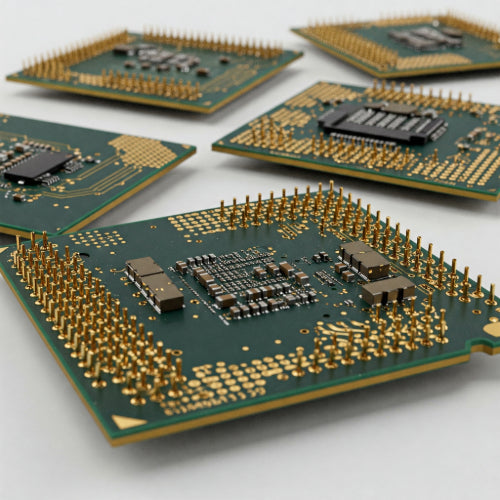Decoding the Brains of Your Machine: Computer Processors Explained
Thinking about buying a new computer? Whether it's a sleek laptop, a powerful desktop, or even a cutting-edge smartphone, one component reigns supreme in determining its performance: the processor, often called the Central Processing Unit (CPU). It's the brain of your device, responsible for executing instructions and running everything from your operating system to your favorite games.
But navigating the world of processors can feel like deciphering a secret code. Terms like "cores," "clock speed," and "cache" get thrown around, leaving many feeling confused. Fear not! This blog will break down the essential aspects of computer processors, equipping you with the knowledge you need to make an informed decision before your next purchase.
The Core Concepts: What Makes a CPU Tick?
Imagine the CPU as a team of super-efficient workers. Each worker can handle a set of tasks simultaneously. These "workers" are called cores.
- Cores: Simply put, a core is an independent processing unit within the CPU. A dual-core processor has two cores, a quad-core has four, and so on. More cores generally mean the CPU can handle more tasks at the same time, leading to smoother multitasking and better performance with demanding applications like video editing or gaming.
- Clock Speed: Measured in gigahertz (GHz), clock speed indicates how many processing cycles a core can execute per second. Think of it as the speed at which each "worker" operates. A higher clock speed generally translates to faster performance for single-threaded tasks (applications that primarily use one core). However, it's not the only factor determining overall speed.
- Cache: This is a small, high-speed memory located close to the CPU cores. It stores frequently accessed data, allowing the CPU to retrieve information much faster than accessing the main system memory (RAM). Think of it as a quick-access notepad for each "worker." More cache can improve performance by reducing the time the CPU spends waiting for data.
Key Specifications to Consider:
When you're looking at processor specifications, these are the terms you'll encounter most often:
- Number of Cores: As discussed, more cores are generally better for multitasking and demanding applications. For basic everyday tasks, a dual-core or quad-core processor might suffice. Gamers and content creators will often benefit from six, eight, or even more cores.
- Clock Speed (Base and Boost): Pay attention to both the base clock speed (the standard operating speed) and the boost clock speed (the maximum speed a core can reach under certain conditions). The boost clock speed is often more relevant for burst performance.
- Cache Size: Look for the different levels of cache (L1, L2, L3). L1 is the fastest but smallest, while L3 is larger but slightly slower. A larger overall cache generally improves performance.
- Integrated Graphics: Many modern CPUs come with integrated graphics processing units (GPUs). These are sufficient for basic tasks, web browsing, and light gaming. However, for more demanding graphics tasks like high-end gaming or video editing, a dedicated graphics card is usually necessary.
- Thermal Design Power (TDP): Measured in watts (W), TDP indicates the maximum amount of heat the CPU is expected to generate. This is important for understanding the cooling requirements of the system.
- Socket Type: This refers to the physical connector on the motherboard that the CPU fits into. Make sure the CPU and motherboard have compatible socket types.
Major Processor Manufacturers:
The two dominant players in the desktop and laptop processor market are:
- Intel: Known for their Core i3, i5, i7, and i9 series (for mainstream to high-end consumer PCs) and Xeon processors (for workstations and servers).
- AMD: Their Ryzen series (Ryzen 3, 5, 7, 9 for consumers and Threadripper for high-end desktops) has become a strong competitor, offering excellent performance at various price points.
Both manufacturers offer a wide range of processors catering to different needs and budgets.
What Do You Need? Matching the Processor to Your Usage:
The "best" processor isn't necessarily the most expensive one. It's the one that best suits your needs and how you intend to use your computer:
- Basic Use (Web browsing, email, word processing): An entry-level dual-core or quad-core processor (like an Intel Core i3 or an AMD Ryzen 3) with integrated graphics should be sufficient.
- Everyday Multitasking (Web browsing, documents, streaming): A mid-range quad-core or hexa-core processor (like an Intel Core i5 or an AMD Ryzen 5) will provide a smoother experience.
- Gaming and Content Creation (Video editing, graphic design): You'll want to look at processors with more cores and higher clock speeds (like an Intel Core i7 or i9, or an AMD Ryzen 7 or 9). A dedicated graphics card is also crucial for these tasks.
- High-End Gaming and Professional Workstations: Enthusiasts and professionals often opt for the most powerful processors available, like Intel's high-end Core i9 series or AMD's Ryzen Threadripper, paired with top-of-the-line dedicated graphics cards.
Making the Right Choice:
Before you click "buy," take a moment to consider how you'll primarily use your computer. Understanding the core concepts and key specifications of processors will empower you to make a more informed decision and choose a CPU that delivers the performance you need without breaking the bank. Don't get caught up in just the highest numbers; focus on finding the right balance of cores, clock speed, and other features that align with your specific requirements. Happy computing!







